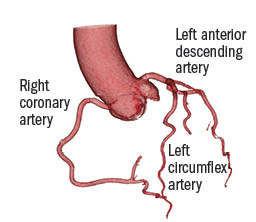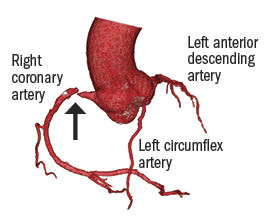A safer way to diagnose coronary artery disease?
Cardiac CT angiography — a noninvasive test to check for clogged heart arteries — is now considered a first-line option for people with suspected heart disease.
- Reviewed by Deepak L. Bhatt, M.D., M.P.H, Former Editor in Chief, Harvard Heart Letter


Angiography, a technique that allows doctors to "see" the heart's arteries, can be done two ways. The first, called invasive coronary angiography (ICA), has been used for more than half a century. It involves snaking a slender tube (catheter) through a leg or arm artery up to the heart and injecting a special dye visible on an x-ray. Rare but occasionally serious complications can occur, including bleeding at the catheter insertion site or damage to the artery.
The second, cardiac CT angiography (CCTA), was developed nearly 25 years ago. This test doesn't require a catheter; rather, the special dye is injected into a vein in the arm or hand. Instead of the standard x-rays used in ICA, the newer test uses a CT scanner, which takes multiple, rapid x-rays that are merged together to create a detailed, three-dimensional view of the heart's arteries.
In the United States, CCTA isn't as widely used as it is in many European countries, which have led the way in adopting this newer test. But that may change. Last year, expert guidelines from the American Heart Association and American College of Cardiology recommended CCTA as a first test for certain people without known coronary artery disease who have stable angina (transient chest pain that occurs predictably during activity or emotional stress).
Who might benefit?
"CCTA is helpful for assessing people with chest pain who have an intermediate risk of coronary artery disease, meaning their chance of having or not having the disease is roughly equal," says cardiologist Dr. Joseph Loscalzo, who chairs the Department of Medicine at Harvard-affiliated Brigham and Women's Hospital. For people with a higher risk, ICA may make more sense than CCTA. That's because if the test reveals an artery severely narrowed by fatty plaque, the cardiologist can reopen the artery with a stent (a tiny wire mesh tube) at the same time. For people with a lower risk, the guidelines recommend forgoing testing and instead focusing on making sure your weight, blood pressure, and cholesterol are under control.
Who's considered to be at "intermediate" risk? An example would be a woman in her early 70s who is overweight and has elevated cholesterol and high blood pressure. If she starts noticing chest pain during exercise (while climbing stairs, for instance), CCTA offers a fast, effective way to see if her coronary arteries are clear — or if they have areas of potentially worrisome plaque.
Promise and limitations
A recent study suggests that CCTA is less risky but just as effective as ICA (see "Angiography: Old vs. new"). Dr. Loscalzo, who wrote an editorial about the study, notes that about 60% of ICA tests reveal no evidence of dangerous plaque. That means many people without significant heart disease are subjected to the low but real risk of complications from ICA. CCTA is a promising alternative, but it's not perfect. Sometimes, arteries take funny turns that can either obscure a true blockage or suggest one that's not actually there, he says.
Just as technologies to diagnose heart disease have evolved, so has the typical heart attack. These days, fewer heart attacks result from big, bulky plaques that choke off heart arteries. Such often-fatal events were more common decades ago, before widespread use of drugs to treat high cholesterol and high blood pressure. Today, most heart attacks occur when plaques rupture and spew out chemicals that trigger artery-narrowing clots. "What we really need is a test that can tell whether you have one of these so-called vulnerable plaques. That's been the holy grail in cardiology for many years," says Dr. Loscalzo.
In the meantime, if you have stable angina and your doctor recommends ICA, ask if CCTA might be an alternative. However, be aware that these tests aren't widely available except at major academic medical centers. And don't forget the time-honored strategy of focusing on a healthy diet, regular exercise, stress management, and medications to lower your risk of coronary artery disease, says Dr. Loscalzo.
Angiography: Old vs. newA team of European researchers compared ICA and CCTA for guiding the treatment of people with stable angina (see main story). Here's a summary of their findings, published April 28, 2022, in The New England Journal of Medicine. Who: 3,561 people (56% women) ages 30 and older from 16 European countries. All had an intermediate risk of heart disease and stable angina and had been advised to have ICA. How: Participants were randomly assigned to receive ICA or CCTA. Those found to have heart disease were treated with medications or procedures according to current guidelines. When: Researchers tracked the participants' heart-related problems for 3.5 years. Key findings: Rates of heart attack, stroke, and death from cardiovascular disease were similar in both groups. But the CCTA group had a lower risk of procedure-related complications. |
CCTA images courtesy of Dr. Ayaz Aghayev, Brigham and Women's Hospital
About the Author

Julie Corliss, Executive Editor, Harvard Heart Letter
About the Reviewer

Deepak L. Bhatt, M.D., M.P.H, Former Editor in Chief, Harvard Heart Letter
Disclaimer:
As a service to our readers, Harvard Health Publishing provides access to our library of archived content. Please note the date of last review or update on all articles.
No content on this site, regardless of date, should ever be used as a substitute for direct medical advice from your doctor or other qualified clinician.
















